The Newfoundland, or Newfie as it is affectionately known, is a gentle giant of a dog, developed as a working water dog in northeast Canada.
With its sticking appearance, there is no mistaking Newfoundlands. They are large, powerful and heavy-boned dogs, weighing up to 80 kgs and reaching up to 71 cm high. Their heads are broad, their eyes soft and soulful, and they have thick double coats and webbed paws. Newfoundlands are most typically seen in black and brown, with white marking on the chest and tail tip. These dogs may be one of the giants of the dog world but they are also one of the gentlest and are well known for their sweet temperament. Newfies are calm, gentle and loyal, and have a natural affinity with children, making them wonderful family dogs. They also happily get along with other household pets and other dogs. This breed requires no more than one hour of exercise every day, which can consist of walks, time playing in the garden, and if possible, opportunities to swim. Gentle exercise for this breed is important, as left to their own devices, they can spend hours lounging around and tend to put on weight. However, care must be taken not to over-exercise puppies whilst their bones and joints are still developing. Grooming is a daily task with Newfies, particularly when they are shedding. In addition, Newfies drool and are quite messy drinkers. Despite this, the Newfie makes a wonderful pet and will suit families and owners who have the space to accommodate this beautiful gentle giant.

History
The specific origins of the Newfoundland are unknown although they are believed to have been bred from dogs brought to Canada by European fishermen and genetically they are related to the Irish Water Spaniel, Labrador Retriever and Curly-Coated Retriever. The breed was developed to be used as working dogs by fishermen in Newfoundland and selective breeding gave them their ribs, oily waterproof coats and webbed feet to aid them in their water work. This work would include hauling in fishermen’s nets and jumping from boats to retrieve lost equipment. In more recent times, their courage and strength in water have seen them used as rescue/lifesaving dogs.





